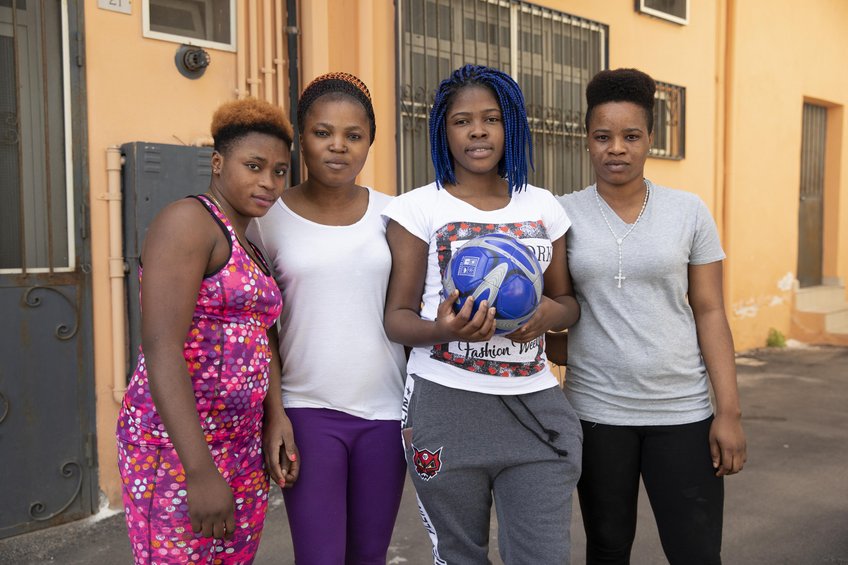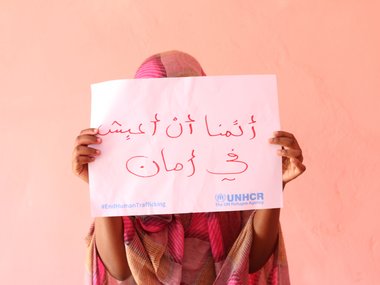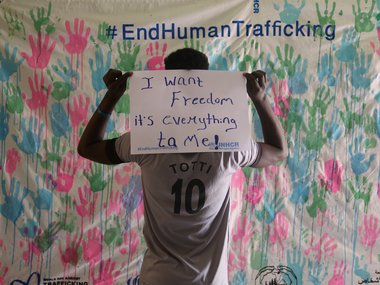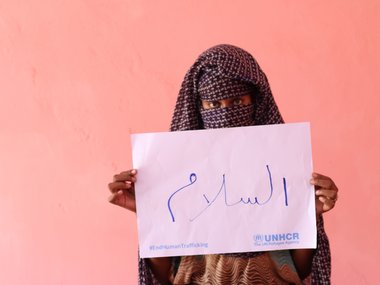In the Light of the Commission’s Intention to Modernise the Current Anti-Trafficking Framework: A Common Victim Identification System?
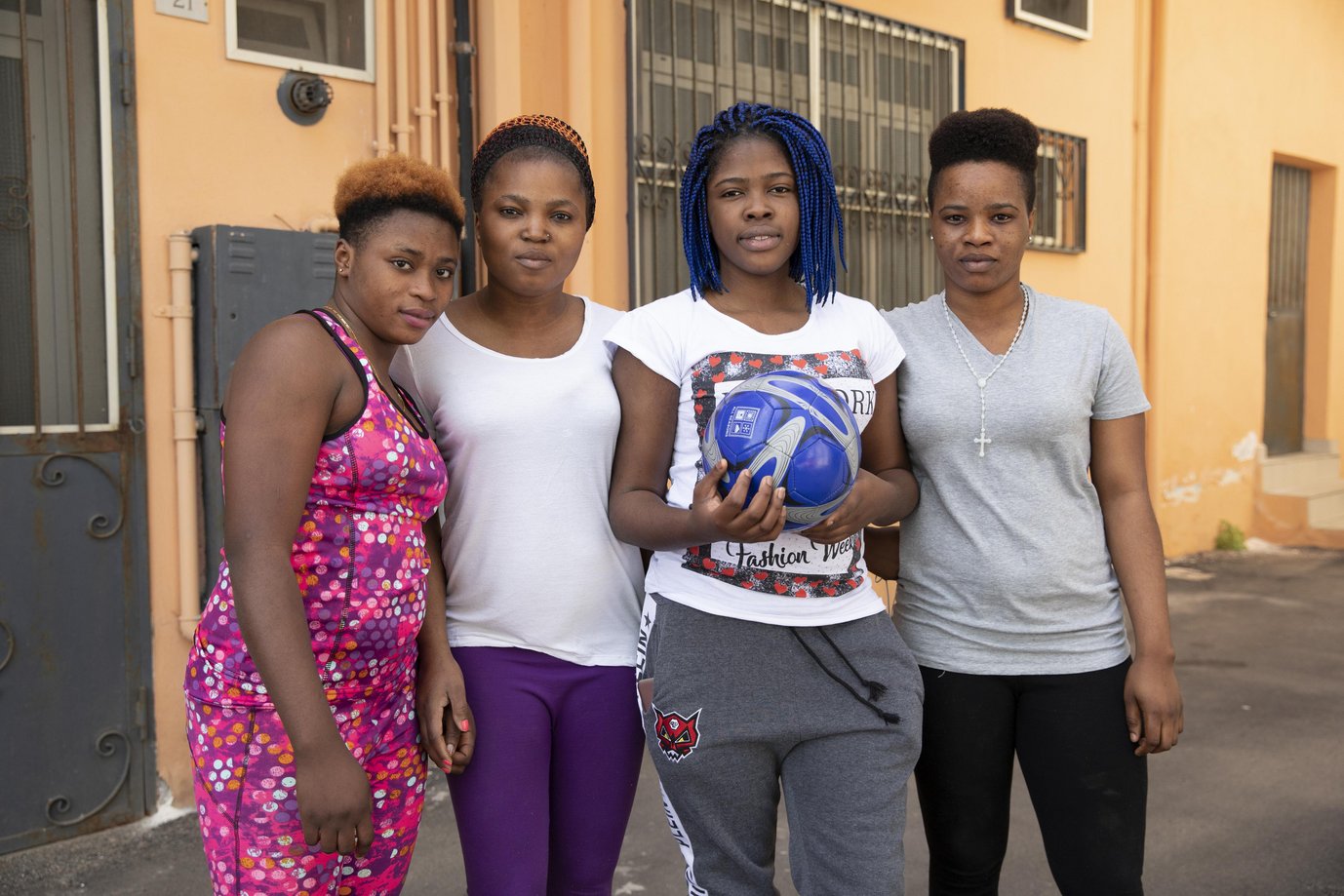
Anita, a 20 year old Nigerian woman explains how she had travelled to Sicily via Libya. “So many people died on the way. The boat was so full, people were biting and kicking to find space. I was trafficked and told I had to sleep with men in order to get into the boat. When I refused I was put into prison where I was raped many times”.
Glory (21) was trafficked from Nigeria and spent 6 months trying to get across from Libya. On the journey she travelled with her best friend who died from hunger and lack of water when they crossed the desert to get into Libya. My best friend who I went through so much with died and I didn't know she was dead until we climbed out of the vehicle. She died of hunger and thirst.
Joy says that she is only alive today because of the kindness of strangers.
Gift trained for sports in her home country and wanted to be a runner but she is no longer able to train. “We left because we were forced into trafficking and now need to start our lives over again”.
This post was also published as a part of a special issue of the Cahiers de l’EDEM, which was edited by Sylvie Sarolea, Zoé Crine, Eleonora Frasca, and Francesca Raimondo.
According to the latest statistics regarding data collection on trafficking in human beings in the EU, during the 2017-2018 period, a total of 26,268 victims of trafficking were registered in the EU28. When breaking down the numbers between the Member States, the profound inequality between registration data is striking. If one looks at the proportion of recorded victims in relation to the population of the State, per 1,000,000 inhabitants, the countries with the highest number of registered victims are Cyprus (156), the pre-Brexit United Kingdom (78) and the Netherlands (56) while the countries with the lowest number are Belgium (3), Spain (5), and Hungary (7). Beyond the unequal records in Member States, these numbers in no way reflect the real number of victims in the Member States, since many victims of human trafficking go unnoticed.
However, victim identification has never been a traditional priority for the Member States, which are persistent in addressing human trafficking from a criminal point of view instead of a human rights one (see McAdam). This perspective is observable throughout Directive 2011/36/EU on preventing and combating trafficking in human beings and protecting victims, hereinafter «the trafficking Directive», which constitutes the European Union’s framework of reference against trafficking. The instrument only contains a brief reference to the identification of victims, stating, in Article 11.4: «Member States shall take the necessary measures to establish appropriate mechanisms aimed at the early identification of, assistance to and support for victims, in cooperation with relevant support organisations.».
Consequently, as Jordana indicates, Member States have full discretion in the choice and development of measures for victim identification, which results in the impossibility of ensuring an accurate and effective identification mechanism. In fact, a Study on national and transnational referral mechanisms for victims of trafficking reveals that victim identification is one of the four main areas for improvement in many Member States. One of the reasons for this is the differences between identification systems. While in some Members, such as Finland, the Czech Republic or Sweden, victim identification is carried out by different actors (i.e. the police, the prosecutor, the border police, the immigration office, and other specialised entities) in other, like Austria, Spain or Bulgaria, victim identification is only entrusted to law enforcement officials.
The urge for an improvement in victim identification has been defined as crucial in the New EU Anti-Trafficking Strategy, where the Commission has committed to providing more support to the Member States in this respect. Likewise, the need for early and proactive identification has also been raised in the new Pact on Migration and Asylum and the EU Strategy for a Security Union.
Hence, if the current system has been demonstrated not to work, it is necessary to go one step further when it comes to identifying victims and their personal situations of vulnerability, as the lack of knowledge of the phenomenon and its complexities brings to their unawareness (See Marchetti and Palumbo) One way would be through the adoption of a common system for the identification of victims across the European Union. For this purpose, the author will analyse the international and European regional frameworks to determine to what extent the obligations arising from them could contribute to its establishment. This will be done by taking into account the Commission's intention to modify the current European framework in the fight against trafficking more than ten years after the adoption of the trafficking Directive.
The International Legal Framework for the Identification of Victims of Human Trafficking
In order to reform the EU framework for identification, it is necessary to first observe to what extent the obligation to identify victims of trafficking is embodied in international law. In this way, obligations arising from International Human Rights Law will serve as a reference and inspiration for the transformation of the Union’s system.
International Human Rights Law and Due Diligence as a starting point.
The international reference regarding the fight against trafficking and the protection of its victims is the 2000 United Nations Protocol to Prevent, Suppress and Punish Trafficking in Persons, Especially Women and Children (Palermo Protocol). Nevertheless, as Gallagher points out, it is discouraging that it does not include any provision for the identification of victims. It is even more discouraging if one notices that the need for such obligation was acknowledged during the negotiations of the Palermo Protocol, as can be observed in the Travaux Préparatoires.
However, the obligation of States to identify victims of trafficking emerges from International Human Rights Law. Such an obligation emanates from international legal texts that do not regulate directly trafficking in persons but some situations which are closely related to it. Those texts have been signed and ratified by the EU Member States. For instance, inter alia, Article 19.2 of the Convention on the Rights of the Child, provides for effective measures for the identification and protection of child victims of trafficking. A similar requirement also arises from Article 3 of the 2014 Protocol to the International Labour Organization Forced Labour Convention, obliging signatory States to take effective measures for the identification, release and protection of victims of forced or compulsory labour.
The obligation to identify victims of trafficking has also been consolidated as an essential part of States' due diligence obligation to protect victims of trafficking. One of the first and most distinguished decisions in this regard was the Committee on the Elimination of Discrimination against Women (CEDAW) decision on the inadmissibility of the case of Zhen Zhen Zheng v. The Netherlands (2008)[1]. Of particular interest is the dissenting opinion of 3 members of the Committee –Mary Shanthi Dairiam, Violeta Neubauer and Silvia Pimentel– in which they stated that the Netherlands had failed to exercise due diligence in the identification of victims of trafficking. Likewise, the Special Rapporteur on Trafficking in persons has also insisted on the State's duty to identify victims.
The Council of Europe and the task of the ECtHR in developing the obligation to identify victims.
In the European regional framework, Article 10 of the 2005 Council of Europe Convention on Action against Trafficking in Human Beings (Warsaw Convention) refers to the identification of victims by establishing, among others, the need for a staff trained for this purpose. However, there is no obligation, as such, to identify victims of trafficking. Likewise, there are no minimum guidelines on how to carry out the identification process.
Nonetheless, thanks to the expansive doctrine of the European Court of Human Rights (ECtHR), the identification of victims of trafficking has become an obligation within Article 4 of the European Convention on Human Rights (ECHR). The first ruling that initiated this doctrine was the Rantsev v. Cyprus and Russia case (2010), in which the ECtHR established that the State's obligation to carry out proactive measures for the identification of trafficking victims raised from the moment when «State authorities were aware, or ought to have been aware, of circumstances giving rise to a credible suspicion that an identified individual had been, or was at real and immediate risk of being, trafficked or exploited» (for case notes see Allain, Pati and Stoyanova). Over time, the ECtHR has further clarified the obligations in the context of victim identification, for instance, in the case of V.C.L. and A.N. v. the United Kingdom (2021) the Court noted the need for early and proactive identification (for case notes see Meninn, Gregory and Ochoa). Likewise, the Group of Experts on Action against Trafficking in Human Beings (GRETA) has pronounced itself in the same direction on different occasions, urging State Parties to the Warsaw Convention to take proactive measures to identify victims of trafficking, particularly amongs asylum seekers.
Therefore, within the framework of the Council of Europe, and owing to the ECtHR doctrine, there is an obligation to identify victims of trafficking from the moment that a State has a plausible suspicion that it is dealing with one. Moreover, State Parties are not only obliged to identify such victims but to do so early and proactively, with trained and qualified personnel. Considering that all Member States of the European Union are State Parties to the Council of Europe and have ratified the Warsaw Convention, the obligations arising from this framework are of great interest for the proposal of an EU-wide common identification system.
Main Challenges of Victim Identification under the Trafficking Directive
The European Union acquis only contains a brief reference to the identification of victims, indicating in Article 11.4 of the trafficking Directive that «Member States shall take the necessary measures to establish appropriate mechanisms aimed at the early identification, assistance and support for victims, in cooperation with relevant support organisations». The Article constitutes an obligation of results in terms of the establishment of mechanisms, but not in terms of the effective identification of victims, meaning a step backwards in comparison to the previous areas explored under international and regional law.
It should be noted that, beyond Article 11.4 of the Trafficking Directive, there is no other provision developing its content. Consequently, as in the framework of the Council of Europe, Member States have full discretion in the choice, design, and development of measures for the detection of victims. Regrettably, discretion may result in some Member States complying only formally with the measures without guaranteeing an accurate and effective identification mechanism. This aspect was rightly pointed out by the European Commission in its 2018 and 2020 monitoring reports of the trafficking Directive. However, regardless of the Commission's remarks, no substantial changes have been made in the interest of mitigating this issue.
The first reports on the implementation of the trafficking Directive did focus on the detection and identification of victims, mentioning the need to carry it out an early way. However, in the latest report (2020), the Commission has focused less on the weakness of the identification system and more on the fact that all Member States have, at least, one measure or procedure for carrying out the identification. Nevertheless, nothing is said about the effectiveness of the aforementioned mechanisms. And rather than just incorporating new mechanisms, what is urgent is that these tools are truly effective in identifying victims and their personal situations of vulnerability.
Per contra, there are other Studies in which the Commission has actually raised concrete challenges for States in victim identification. For instance, the specific adaptation of their systems to the identification of non-EU victims results in an insufficient detection of victims or potential victims who are EU citizens. The European Union Agency for Fundamental Rights (FRA) has also pointed out the shortcomings of some States in the detection and identification of minors, a group at high risk of being exploited.
The improvement of the identification of persons with high vulnerabilities to trafficking is essential and it will be central in the proposal of an EU-wide identification system. Particularly, attention to victims should be paid in border zones, which are commonly frequented by people at a higher risk of falling into the hands of traffickers. Thus, an early and proactive identification is especially needed there.
All of this only further accentuates the need for a homogeneous system for the identification of victims of trafficking. The best way to move towards a common victim identification system, inspired by International Human Rights Law, is to establish the obligation to identify victims effectively as well as to incorporate clear guidelines and procedures to be followed at each step.
Elements for a Harmonized System for the Identification of Trafficking Victims
Having pointed out the international and European framework on which the identification is based, there are four main elements which would serve as the backbone of an EU-wide identification system.
Equal, proper, and updated training
In order to carry out an effective identification of victims, those who enter in direct contact with them must be constantly and adequately trained. This need is foreseen in the third paragraph of Article 18 of the trafficking Directive and its recital (25), which sets out the different categories of professionals among whom such training should be promoted, such as immigration officials, public prosecutors, labour inspectors, or social, child and health care personnel. From the list emerges that States should take an active role in involving and training a wider range of actors in the identification process, and not just law enforcement officials or border agents.
The lack of training of professionals involved in the process of detecting victims has been constantly pointed out by civil society organisations. Furthermore, the practice reveals a deficit in the detection of cross-border victims or minors, who are in an exposed position. This could change in the EU-wide identification system, where some European agencies could play a crucial role.
One is CEPOL, which aims for European and international police cooperation through training. Among its projects, CEPOL is leading the operational action EMPACT THB from the programme «Capacity building through training, networking and innovation», which develops multidisciplinary training in the fight against trafficking, including the identification of victims. Moreover, CEPOL also offers explicit courses to train police forces in the detection and identification of victims of trafficking in human beings.
In the same vein, Frontex is another EU agency to participate in the training of authorities who may have direct contact with victims of trafficking. Frontex has developed a wide range of tools aimed at improving the identification in EU Member States and Schengen partner countries with an external border to the EU free movement area. For instance, it is responsible for the ongoing training of border agents in the detection of potential victims of trafficking and their referral to national procedures.
CEPOL and Frontex could provide this training in collaboration with the European Institute for Gender Equality (EIGE) and the FRA, since they can provide a human rights perspective in favour of the identification of vulnerabilities of people exposed to trafficking. This training should be a priority in the proposed system for victim identification, particularly in migration flows and international protection systems. If training is provided on consistent guidelines across all Member States, they will all enjoy the same level of instruction, allowing a uniform level of performance and results throughout the Union.
Moreover, other EU agencies could get involved in this process, such as EUROPOL and EUROJUST. These agencies have first-hand knowledge of the new techniques used by traffickers, especially those that take advantage of victims' vulnerabilities, and they could keep the training curricula of border guards’ agents updates. Therefore, they could co-operate more closely with EU agencies responsible of said training. If staff at the border is up to date with the latest techniques employed by traffickers, they will be more effective in the detection of victims or potential victims and will be able to proceed quickly to their protection.
By increasing the training of a variety of actors involved in border control, another obstacle that should be removed is stigmatisation. In fact, as Haverkamp points out, the conception of the «ideal victim» presupposes that a certain profile of women and children are victims of trafficking and, as a result, a significant number of victims are not identified and protected. Stereotyping and discriminatory attitudes based on gender, race or the social status of victims by staff who come into contact with them must be eradicated. For this purpose, training is the best ally, as it can contribute to the removal of existing stigmas in the identification of victims and target individualised groups, which are most vulnerable to trafficking.
Unique guidelines for different professionals
Late identification of victims results in delayed access to the support and assistance system that they need. For this reason, early, proactive and preventive identification is necessary, as the actual reactive system not only responds to a criminal approach to the phenomenon but is also insufficient in terms of compliance with international standards. For this task, two elements are indispensable: the professionals involved and the guidelines they follow.
Currently, each Member State has its own identification system, resulting in a diversity of actors across the Union. For example, in Spain, the identification of victims of trafficking is carried out exclusively by law enforcement officers, while in other EU countries, such as Sweden, Italy, Finland, the Czech Republic or Croatia, there are further professionals involved, namely labour inspectors, asylum or migration officers, health professionals or civil society organisations, among others. As long as it is coordinated, the diversity of professionals entrusted with the detection and identification of victims can only lead to better results, which is why it should be one of the points to be strengthened in the EU-wide identification system.
It must also be ensured that professionals receive clear and homogenous guidelines on how to act in order to fulfil their roles. In this way, each actor would have an established function, avoiding both overlaps and gaps throughout the process that lead to the late identification of the victims or, in the worst-case scenario, to non-identification. A proactive system should prevail, consisting of the implementation of measures to prevent potential victims from falling or falling back into the hands of traffickers when they present high vulnerabilities to exploitation. For instance, through prevention and information campaigns in cross-border points, refugee camps or asylum systems.
Two unique and common thresholds
A distinct challenge that the EU-wide identification mechanism could address is the threshold used for the identification of victims, which means the point at which a person is considered to be a victim of trafficking. This aspect was already highlighted in the second monitoring report of the trafficking Directive (2018), emphasising the differences between thresholds applied by the Member States. However, in the third monitoring report (2020), no mention was made of this, which indicates that, despite the cautioning from the European Commission, no initiative has been taken to solve this problem.
It would be desirable to establish two thresholds in the identification of victims, a first threshold that covers the most basic needs such as health and psychological assistance, accommodation, and legal assistance, and a second one that already implies the status of a victim of trafficking. In this way, protection would be offered without delay already before it is established if the person is or is not a victim of trafficking since, in those cases, protection is essential from the very first moment.
Likewise, the threshold at which someone can be considered a victim of trafficking should be determined when there are reasonable grounds to believe that he or she is a victim of trafficking rather than when there is clear evidence of it. The threshold for the identification of victims of trafficking is currently too high, leading to the misidentification of victims or potential victims.
The incorporation of a unique threshold in the EU-wide mechanism would prevent similar human trafficking situations from having different results in different Member States and would guarantee equal chances in identification and protection of the victims. Moreover, it would avoid the long wait that victims face during the identification process to access minimum rights, which can result in the State failing in its duty to protect the victims’ rights.
Common indicators would be the basis for the creation of these thresholds and for ensuring the same level of detection. The establishment of harmonized indicators would allow Member States to encompass all vulnerabilities to the different forms of exploitation of which many Member States agents are not even aware. If all Member States would use the same criteria for the detection of victims, identification practices will not result in stigmatisation and victims will be equally and duly protected across the EU.
Cooperation with civil society organizations.
Finally, another issue that arises from the identification of victims of trafficking is the strength of cooperation between the different actors taking part in the process, including civil society organizations.
It has already been noted that the involvement of different professionals throughout the process is essential, but this involvement is intrinsically linked to their cooperation with civil society actors. Cooperation can lead to synergies that could be of great benefit for the victims. Unfortunately, they are excluded from the identification process in many Member States. These organisations have staff specifically trained for the identification of victims and their vulnerabilities, and with whom the victims might have built relationships of trust or might experience feelings of safety. This is not necessarily true for law enforcement officers, who are seen by the victims as a threat due to their irregular status or because of the possibility of being punished for acts carried out in their condition of victims. Therefore, the participation of civil society in the process is cardinal and must be ensured.
On that account, the EU-wide common system for the identification of trafficked persons should establish clear guidelines for the participation of civil society organizations in procedures for the identification of victims or potential victims, especially in locations with high risk of trafficking. It would also be advisable to involve them in the training of professionals in charge of identifying victims, as they can provide a distinct but enriching point of view.
Conclusion
In view of the Commission’s intention to modify the current EU framework in the fight against human trafficking, it would be desirable to proceed with the establishment of a common system for the identification of victims of trafficking and their vulnerabilities, a unique identification procedure with trained personnel capable of carrying out a correct, early and proactive identification. The system would be adopted not only reactively but also preventively. Likewise, such a system would ensure border cooperation between State actors and civil society organizations, which already play a key role in the identification of victims.
This research shows that such a harmonised system would contribute to improving three important aspects of victim identification and their vulnerability. Firstly, knowing that most of the victims go unnoticed, it would increase the number of victims or potential victims identified in the Member States at an early stage, especially, the ones presenting more vulnerabilities, as there would be an improvement in training and the involvement of different specialised actors. Secondly, it would favour the States’ compliance with their obligations of protection and assistance to victims, ultimately respecting their human rights. And thirdly, it would contribute to the reduction of inequalities in between the number of victims registered in the Member States.
Therefore, establishing a formal common EU-wide victim identification system is one of the ways for addressing the misidentification problem that the trafficking Directive alone cannot solve. Only with coherence and equality and through the pursuit of a genuine human rights approach, Member States will ensure that trafficked victims are taken seriously and that the most vulnerable groups are duly protected.
[1] The complaint was not admissible under article 4, paragraph 1, of the Optional Protocol to CEDAW on the grounds that all available domestic remedies had not been exhausted. See, CEDAW/C/42/D/15/2007
